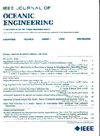基于贝叶斯深度学习的合成孔径声呐成像伪影分类
IF 5.3
2区 工程技术
Q1 ENGINEERING, CIVIL
引用次数: 0
摘要
合成孔径声呐(SAS)提供高分辨率的水下成像,但由于环境或导航错误,可能会受到伪影的影响。这项工作探讨了贝叶斯深度学习在量化模型可靠性的同时对常见的成像伪影进行分类。通过控制波束形成扰动,引入一种具有模拟成像误差的标记数据集。两种贝叶斯神经网络变体,蒙特卡罗dropout和flipout,在这些数据上进行训练,以检测由声速误差、偏航姿态误差和加性噪声引起的三种伪影。结果表明,这些方法可以准确地对SAS图像中的伪影进行分类,同时产生校准良好的不确定度估计。对于均匀的海底纹理,不确定性往往更高,因为人工制品更难被感知,而对于纹理丰富的环境,不确定性则更低。对不确定性的分析揭示了可能被错误分类的区域。通过丢弃20%最不确定的预测,分类从0.92 F$_{1}$-score提高到0.98 F$_{1}$-score。总的来说,贝叶斯方法实现了不确定性感知,提高了模型的可靠性——这是现实世界自主水下系统的基本能力。这项工作将贝叶斯深度学习建立为SAS中不确定性量化和伪迹检测的鲁棒技术。本文章由计算机程序翻译,如有差异,请以英文原文为准。
Classification of Imaging Artifacts in Synthetic Aperture Sonar With Bayesian Deep Learning
Synthetic aperture sonar (SAS) provides high-resolution underwater imaging but can suffer from artifacts due to environment or navigation errors. This work explores Bayesian deep learning for classifying common imaging artifacts while quantifying model reliability. We introduce a novel labeled data set with simulated imaging errors through controlled beamforming perturbations. Two Bayesian neural network variants, Monte Carlo dropout and flipout, were trained on this data to detect three artifacts induced by: sound speed errors, yaw attitude error, and additive noise. Results demonstrate these methods accurately classify artifacts in SAS imagery while producing well-calibrated uncertainty estimates. Uncertainty tends to be higher for uniform seafloor textures where artifacts are harder to perceive, and lower for richly textured environments. Analyzing uncertainty reveals regions likely to be misclassified. By discarding 20% of the most uncertain predictions, classification improves from 0.92 F$_{1}$ $_{1}$
求助全文
通过发布文献求助,成功后即可免费获取论文全文。
去求助
来源期刊

IEEE Journal of Oceanic Engineering
工程技术-工程:大洋
CiteScore
9.60
自引率
12.20%
发文量
86
审稿时长
12 months
期刊介绍:
The IEEE Journal of Oceanic Engineering (ISSN 0364-9059) is the online-only quarterly publication of the IEEE Oceanic Engineering Society (IEEE OES). The scope of the Journal is the field of interest of the IEEE OES, which encompasses all aspects of science, engineering, and technology that address research, development, and operations pertaining to all bodies of water. This includes the creation of new capabilities and technologies from concept design through prototypes, testing, and operational systems to sense, explore, understand, develop, use, and responsibly manage natural resources.
 求助内容:
求助内容: 应助结果提醒方式:
应助结果提醒方式:


